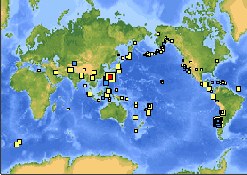Recent earthquakes
by David Bradley
 Earthquakes (quakes, earth tremors) are caused by the sudden release of energy in the Earth's crust. Earthquakes are
usually caused by a rupture along geological faults, but can also be triggered
by volcanic activity. There are literally hundreds of earthquakes each year.
Recent earthquakes in Szechuan, Haiti, and Chile have caused significant loss of
life, injury, and damage to property.
Earthquakes (quakes, earth tremors) are caused by the sudden release of energy in the Earth's crust. Earthquakes are
usually caused by a rupture along geological faults, but can also be triggered
by volcanic activity. There are literally hundreds of earthquakes each year.
Recent earthquakes in Szechuan, Haiti, and Chile have caused significant loss of
life, injury, and damage to property.
The magnitude of an earthquake is recorded with a seismometer (seismograph). The moment magnitude (the Richter scale is now obsolete) of an earthquake is conventionally reported, with magnitude 3 or lower earthquakes being mostly imperceptible and magnitude 7 causing serious damage over large areas. Intensity of shaking is measured on the modified Mercalli scale.
At the Earth's surface, earthquakes manifest themselves by shaking and sometimes displacing the ground. An earthquake's point of initial rupture is called its focus or hypocentre. The term epicentre refers to the point at ground level directly above the hypocentre. When a large earthquake epicentre is located offshore, the seabed sometimes suffers sufficient displacement to cause a tsunami (a potentially enormous and devastating oceanic wave). The shaking in earthquakes can also trigger landslides and occasionally volcanic activity.
The USGS newsfeed for recent significant earthquakes is here.